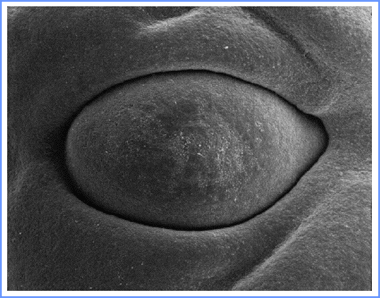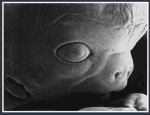Have you ever thought about what a baby is actually seeing when it is still in the belly? Or you thought, as well as my daughter, that since the baby is in the dark and in the water, it does not open eyes until it gets out and development of vision just starts at the second when the baby leaves the belly? Yet it seems, that not only that visual system as the whole is developing already since the 4th week of pregnancy (wiring important neural connections, building up tissues, lenses, muscles, and all the other necessary stuff,…), but the baby can actually see inside the womb some light, after 26 weeks it can open eyelids and it keeps eyes open when awake, it reacts to intense light and some recent studies suggest even so crazy ideas such as that babies might recognize faces already in the womb – as it seems that the baby reacts to the light in the shape of face more than to light in different shapes – crazy, right?
Development of the visual system
From the beginning of the 2nd month of pregnancy (at around 4 weeks), the development of the visual system and eyes starts and for next few weeks you can see such a rapid development of all the important parts of the visual system that it seems almost incredible. The fetus is really busy with creating all eye structures and corresponding neural connections. As stated in very nice course [4]: “Eye development during the first trimestr of pregnancy is like watching the grand finale of Fourth of July fireworks. Cells and tissues develop quickly and simultaneously to form various eye structures.”
At 4 weeks precursor to 2 optic nerves (optic stalk) is created (it is developed at 36 days). Optic nerves create a crucial connection between eyes and forebrain (each one connecting eyes to the one side of the brain) [2, 4]. In parallel, at 4 weeks, first cells start the baseline for lens (which will help the kid to focus on objects), at 32nd day we can already identify them and by the end of the 2nd month of pregnancy they will grow to the size which they will have at birth [4]. Also, at 30-35 days of pregnancy iris (which helps to reduce the amount of light coming to the eye) start to develop and 2 weeks later it is ready. At 4 weeks of pregnancy also extraocular muscles are created, as well as the cornea is developing at this time. The retina (layer in the back of the eye covered by photoreceptors which perceives and processes light and sends signal to the brain) starts its development around 8 weeks of the gestation age.[4]

Eyelids start to form around 8 weeks. They are closed and serve as a protection for other developing eye structures [4]. At 16 weeks, the eye is starting to pick up on light and can perform slight movements from side to side in response to light [2]. By this time, eyelids are still fused and closed. From the beginning of the 5th month till the end of the 6th month, eyelids are slowly separated. At 26 weeks (7 month) of gestation age, highly-hydrated cornea starts to be transparent and enables eyes to sense light. Eyelids finally open. [4] Since then the baby keeps eyelids open when awake. It seems, that the baby is from now on able to sense the movement of bright light outside your body – if you flash bright light to the belly, you might get “kick” response. Between 28 – 30 weeks, rapid eye movements and sleep patterns appear. As will be mentioned later, the REM sleep and sleep patterns are crucial for healthy vision development as they synchronize brain waves of visual system with retina [4].
How dark is it in the womb and how the baby reacts to the light?
As we could see, in the last 2 months of the pregnancy (from the week 30-32), the visual system is already developed enough to be able to react to the incoming light and process some incoming visual information – although with a lower acuity (fetuses would only be able to see large objects or smaller objects close by) and mainly in the grayscale (as the cones are not yet developed). So the question is – how much the baby can actually see in there? Marco del Giudice used measured transmission coefficients of biological tissues and modeled light transmission from the external environment to the uterine cavity. He found out that for the naked woman, around 0.1-1 % of ambient light might get inside the womb. This amount is highly variable and depends on the thickness of the tissue (how fat is the belly) and the strength of the external illumination [7, 8].
Now the question is, how much light is needed for prenatal visual experience? Glass [9] review of studies with newborns (term and premature) suggest that the amount of light needed for fetal vision is way lower than the one of mature individuals. [7] makes a conservative estimate of the amount of light permitting vision of fetus to 10 lx (this is light which an adult needs to read a text). Study published by [7] shows that we can expect that fetus in the womb receives at least 10-100 lx, therefore its visual experience is enabled.
In the recent study (2017) [10] V. Reid et al. used a 4D scanner to explore how fetus reacts to the light source in different shapes. On top, the response of the fetus was recorded when the light source was moving. The visual stimuli was projected through the uterine wall and fetal head turns were examined. They found out that fetus in the third trimester looks toward three dots which are configured upright like a face significantly more than to three inverted configuration dots (the stimuli they used is shown on the figure – and as you can see, interpreting it as face is somehow not that intuitive…at least not for me 🙂 ).
So it seems that the womb is not that dark place after all…
What can we do during pregnancy for the vision of our baby?
(…how we can help to maintain healthy development of eyes and vision of our precious one?)
It seems that the most important for visual system development is genetic coding [1] (you cannot do much about this part :)), certain nutrients – particularly vitamin A [1,2,5](you can find it in fruits, dairy products and mainly in leafy vegetables), and keeping REM sleep and sleep cycles of the baby undisturbed. Why is REM sleep and sleep cycles so important for the visual system development? During its life in the womb, the brain of the fetus creates topographic relationships between retina, lateral geniculate nucleus and primary visual cortex. To create those mappings correctly, REM sleep (accompanied by rapid eyes movement) and sleep cycles seem to be crucial and sleep disturbance or deprivation might result in the fact that these important bindings are not created properly [1].
So maybe we should not try too often to make the baby move by pushing, flashing light to the belly, or impose it to loud noises (you shouldn’t anyway)…
Is it good to stimulate a fetus by light before birth or not?
There is no doubt that simulation of the vision after birth is very important for newborn visual system development [1]. On the other hand, there is contradictory evidence whether simulation of visual system before birth might be beneficial or not. [1] states that it is not important and the visual system cannot benefit from it. On the contrary, there is a study done on pregnant mice [6], which were kept in complete darkness and after birth, their babies were more likely to have vision problems. This study states that fetal mice require light exposure in utero during early gestation for normal vascular development in the eye. In parallel, there were done studies on the pregnant women who live at northern latitudes with pregnancy lasting during the darkest months of the year. Surprisingly, their babies have actually increased risk of certain eye disorders [2,6]. These studies suggest that stimulation of the visual system is important – at least to some extent. Anyway, it doesn’t mean that you should be flashing light to your belly to keep your baby stimulated. Just do not stay inside a cave all the time :).
Note: Keep in mind that pupils start to respond to light earliest in the 8th month and it takes another 2 weeks until the response is consistent. That is why premature babies (born before 34 weeks of gestation) need eye protection to let the eye finish its full development. The need to protect the underdeveloped visual system from light outweighs the benefits of its stimulation until the premature infant is reaching the age typicall for leaving the womb – 40 weeks of gestation. [4]
Can a baby in the womb cry?
Lacrimal glands (where tears are produced) begin to form already during the 6th week of pregnancy. However, they do not produce no tears until the third month after birth, which is why infants shed no tears when they cry. [4]
Does a fetus/newborn see in colors?
It is important to notice that the retina development goes on from 8 weeks of gestation age till 3-4 months after birth. So at the time when the baby first comes to the world, the optic nerve is still not fully myelinated and rods (photo receptors responsible for grey-scale vision enabling us to see in the dark) are way better developed than cones (enabling color vision). Therefore, newborn cannot see in colors, but mainly perceives shades of gray and discriminates between dark and light. The color vision (enabled by red, green and blue cones) will come later – around 3 months of age – together with maturation of cones [4]. Maturation of the whole visual system and corresponding neural areas will still go on…
Read more…
[1] Graven, 2008: Visual Development in the Human Fetus, Infant,and Young Child https://www.sciencedirect.com/science/article/abs/pii/S1527336908001359
[2] https://www.whattoexpect.com/pregnancy/fetal-development/fetal-eyesight/
[3] https://www.businessinsider.com/fetus-vision-hearing-development-uterus-2016-9
[4] https://www.2020mag.com/ce/embryonic-eye-development-abo-and-7A85C
[5] See, Angela Wai-Man, and Margaret Clagett-Dame. “The temporal requirement for vitamin A in the developing eye: mechanism of action in optic fissure closure and new roles for the vitamin in regulating cell proliferation and adhesion in the embryonic retina.” Developmental biology 325.1 (2009): 94-105. https://www.ncbi.nlm.nih.gov/pubmed/18955041
[6] Yang, Michael B., et al. “Length of day during early gestation as a predictor of risk for severe retinopathy of prematurity.” Ophthalmology 120.12 (2013): 2706-2713. https://www.aaojournal.org/article/S0161-6420(13)00691-X/abstract
[7] Del Giudice, Marco. “Alone in the dark? Modeling the conditions for visual experience in human fetuses.” Developmental psychobiology 53.2 (2011): 214-219. https://onlinelibrary.wiley.com/doi/abs/10.1002/dev.20506
[9] Glass, P. (2002). Development of the visual system and implications for intervention. Infants and Young Children, 15, 1 – 10
[10] Reid, Vincent M., et al. “The human fetus preferentially engages with face-like visual stimuli.” Current Biology 27.12 (2017): 1825-1828. https://www.sciencedirect.com/science/article/pii/S0960982217305808
[11] https://syllabus.med.unc.edu/courseware/embryo_images/


Hi, the Is it really that dark in the womb? Development of fetus vision. article it is well written and is
very useful.
That’s how easy it can be to finally enjoy restful nights and see the surpring health benefits for your
child. – http://bit.ly/Gets-Your-Baby-to-Sleep
Your baby is wonderful!! 🙂 Kiss you All!
Thank you for your comment :).
I am very happy to find & read your blog. thanks for sharing these points, very useful for me. Thanks again for the insight
Regards
Hi, very happy to hear that. I had a short break in writing, but now I am preparing new content, hope you will like it as well:-) Best, Karla
Excellent read, I just passed this onto a friend who was doing a little research on that. And he just bought me lunch because I found it for him smile Therefore let me rephrase that: Thank you for lunch!
That made me really smile. Thank you for that 🙂